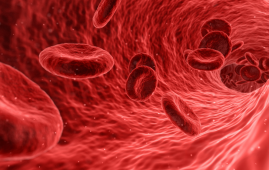

Tumor cells are notoriously erratic sleepers, frequently laying dormant in distant regions for years before reactivating and generating metastasis. Numerous elements, ranging from cells and molecules to other components in the so-called tissue microenvironment, have been researched to better understand why activation occurs. An interdisciplinary Cornell team has discovered a new mechanism that regulates tumor growth in the skeleton, the primary site of breast cancer metastasis: mineralization of the bone matrix, a fibrous mesh of organic and inorganic components that determines our skeleton’s unique biochemical and biomechanical properties.
The team’s paper, “Bone-Matrix Mineralization Dampens Integrin-Mediated Mechanosignalling and Metastatic Progression in Breast Cancer,” published Aug. 7 in Nature Biomedical Engineering. The co-lead authors are research associate Siyoung Choi and doctoral student Matthew Whitman.
Claudia Fischbach, the Stanley Bryer 1946 Professor of Biomedical Engineering, and Lara Estroff, the Herbert Fisk Johnson Professor of Industrial Chemistry, both of Cornell Engineering, have been researching the metastatic spread of breast cancer to bone for more than a decade.
Fischbach’s lab uses biomaterials in conjunction with cellular and tissue engineering approaches to investigate how the tissue microenvironment regulates cancer in various contexts, whereas Estroff’s group specializes in biomineralization, or how biological organisms control crystal growth in their tissues.
“We know that cancer cells behave like seeds that need the right soil to grow, and we’re very interested in how the extracellular matrix, which is basically the material in between cells that holds everything together, affects tumor growth,” Fischbach said.
Bone mineral particles are deposited in and around collagen type I fibers during physiological mineralization. This process happens naturally and is required for bone health, although it declines with age, for example, due to hormonal changes seen in menopausal women. It can also occur as a result of dietary changes or treatment.
The link between poor bone health and tumor cell activity is widely known. For example, lower bone mineral density has been linked to an increased risk of metastasis, and inadequate fracture repair has been linked to higher bone metastasis. However, no one has been able to pinpoint the precise role of bone matrix mineralization in this process.
“You can’t study some these connections unless you have model systems in which you can control bone matrix properties in a defined way,” Fischbach said.
The researchers created such systems by combining organic and inorganic matrix components, including as collagen and the bone mineral hydroxyapatite, in a way that simulated healthy and pathologic mineralization. Estroff oversaw the materials synthesis and characterization processes for the various bone matrix models, which the researchers then utilized to study tumor cell activity in vitro and then in vivo using animal models.
In both cases, the presence of bone mineral inhibited tumor cell proliferation. The presence of mineral also caused tumor cells to boost genes associated with a better prognosis for patients. These findings imply that a healthy bone matrix may minimize the incidence of skeletal metastases in breast cancer.
Co-authors Matthew Paszek, associate professor in the Smith School of Chemical and Biomolecular Engineering, and Olivier Elemento, director of the Englander Institute for Precision Medicine and a professor of physiology and biophysics and of computational genomics in computational biomedicine at Weill Cornell Medicine, helped elucidate how bone matrix regulates cellular mechanosignaling, and connect the potential molecular mechanisms to patient data.
“This study basically shows for the first time that physiological interactions between mineral particles and collagen may be able to inhibit the activation of tumor cells that have spread to bone,” Fischbach said. “Now we’re broadly interested in how other cell types are influenced by varied bone-matrix mineralization. And how do mineral-dependent changes of their behavior regulate tumor cells?”
more recommended stories
 Fat-Regulating Enzyme Offers New Target for Obesity
Fat-Regulating Enzyme Offers New Target for ObesityKey Highlights (Quick Summary) Researchers identified.
 Spatial Computing Explains How Brain Organizes Cognition
Spatial Computing Explains How Brain Organizes CognitionKey Takeaways (Quick Summary) MIT researchers.
 Gestational Diabetes Risk Identified by Blood Metabolites
Gestational Diabetes Risk Identified by Blood MetabolitesKey Takeaways (Quick Summary for Clinicians).
 Phage Therapy Study Reveals RNA-Based Infection Control
Phage Therapy Study Reveals RNA-Based Infection ControlKey Takeaways (Quick Summary) Researchers uncovered.
 Pelvic Floor Disorders: Treatable Yet Often Ignored
Pelvic Floor Disorders: Treatable Yet Often IgnoredKey Takeaways (Quick Summary) Pelvic floor.
 Urine-Based microRNA Aging Clock Predicts Biological Age
Urine-Based microRNA Aging Clock Predicts Biological AgeKey Takeaways (Quick Summary) Researchers developed.
 Circadian Control of Neutrophils in Myocardial Infarction
Circadian Control of Neutrophils in Myocardial InfarctionKey Takeaways for HCPs Neutrophil activity.
 E-Cigarette Use and Heart Attack Risk in Former Smokers
E-Cigarette Use and Heart Attack Risk in Former SmokersKey Takeaways for Clinicians and Nurses.
 36-Week Pre-eclampsia Screening May Reduce Term Risk
36-Week Pre-eclampsia Screening May Reduce Term RiskA New Preventive Strategy for Term.
 Cardiovascular Risk and Sudden Cardiac Death in Diabetes
Cardiovascular Risk and Sudden Cardiac Death in DiabetesRising Sudden Cardiac Death (SCD) Risk.

Leave a Comment